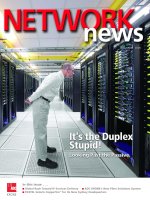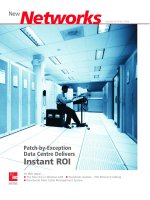ADC KRONE Network News - Vol.11 No.5 - 2004
Bạn đang xem bản rút gọn của tài liệu. Xem và tải ngay bản đầy đủ của tài liệu tại đây (700.06 KB, 16 trang )
Vol11 No5 2004
W
hile the corporate world is
embracing the next generation
network and taking advantage of
emerging IP applications to save costs
and streamline communications, these
new technologies are now beginning to
filter through to our homes.
There’s no doubt that home
networking has been heralded as the
next big thing, with a whole array of
applications now being made readily
available to the consumer. Inside this
issue, Rob Milne takes a closer look at the
emergence of the home networking
market in Australia, discussing the opportunities it
holds for a variety of parallel industries on page 4.
With the onset of home networking, it’s no
surprise, that KRONE, the most trusted name in
network cabling, with a wealth of experience in
structured cabling systems and installations in
literally every office in Australia, has developed a
solution for the home marketplace. Smart
Broadway, is designed to streamline the
convergence of these new technologies within
the home. Further information on the Home
Show and Broadway can be found on the back
cover of this issue.
On page 8, we continue to cover the theme of
future applications for emerging technologies,
with KRONE UK’s Mansel Healy discussing the
implications of new technology uptake within the
corporate arena, providing a timely warning to
those who may decide to wait on the sidelines
and be sadly left behind.
As a leader in new technology, our aim is to not
only provide future solutions to the marketplace,
but to also make them the best quality available.
It was therefore pleasing to have this confirmed at
the recent Victorian NECA awards where KRONE
featured as the vendor of choice for two award-
winning installers. Trevor Kleinert has the full
details on the awards in his article on page 3.
Finally, we review two corporations who have
recently installed KRONE solutions to meet their
future needs. On page 12, we feature the first
installation of our innovative Category 6 Angled
Patch Panel system at the NSW Audit Office,
followed by PMI Mortgage’s streamlined
HIGHBAND
®
25 solution.
Best of luck with this final quarter of 2004. May
the future technologies of tomorrow be providing
your business of today!
Sincerely
Craig Jones
Managing Director
2
{
NETWORKnews
THE FUTURE IS NOW
Consumers and corporations scramble to adopt new technologies
Customer Stories
12 New Angle Streamlines
Audit Office
14 PMI Insures Future With
A HIGHBAND 25 Network
Business Articles
4 Cabling The Home For An IP World
8 Cable Lagging Caution
11 Here’s The Drum About The TIN
KRONE News
3 Vendor Of Choice
13 KRONE Invests In Technology
Futures
15 Club KRONE End Of Year
Editor: Joanna Parsons
Art Direction: Nora Collins
Website: krone.com.au
Email:
CONTENTS
Copyright © 2001 KRONE Australia Holdings Pty. Limited
I
n late July KRONE was announced as the vendor
of choice at the Victorian NECA Awards in two
categories - under $500,000 Data Project and
over $500,000 Data Project.
Congratulations to endorsed installer,
Newscom, who primarily used KRONE’s
HIGHBAND
®
25 products for their winning
installation at NMIT (Northern Metropolitan
Institute of Technology) with Ideal as the supplier
in the under $500,000 Data Project category.
Commendations also go to Bell Technologies
who chose a KRONE HIGHBAND 25 system for its
winning installation at Toyota’s new corporate
headquarters, in the over $500,000 Data Project
category, again with Ideal as the supplier of the
product.
This, once again highlights the dominance of
KRONE Australia in the marketplace, not to
mention the continued success of HIGHBAND 25.
NEW FACES AT KRONE
With the recent promotion of Alex Price to the
position of NSW State Manager, I am pleased to
announce the appointment of Ade Croucher to
the position of Technical Sales Engineer. Ade will
be responsible for concentrating on both pre
and post-sales functions for the NSW and ACT
markets.
Ade is a CCNA (Certified CISCO Network
Administrator) and has a wealth of experience
and technical knowledge in the data
communications field and will, no doubt,
enhance our success in NSW.
I am also pleased to announce the appointment
of Jason Thiesfield to the position of Sales
Executive in our Queensland office. Jason has over
nine years experience in the telecommunications
arena and will be a solid addition to the
Queensland team, helping to further cement our
position as market leader. p
NETWORKnews
{
3
VENDOR OF CHOICE
KRONE cleans up at NECA Awards
By Trevor Kleinert,
RCDD, National Sales
Manager Premis
NET
,
Manager Fibre
Optics Division,
KRONE Australia
Jason Thiesfield
Sales Executive, Queensland
Ade Croucher
Technical Sales Engineer, NSW
NEW FACES
AT KRONE
E
ntertainment, security and access to
technological services within the home are now
clearly important purchasing decisions on the
minds of new home buyers according to a recent
HIA survey (see figure 1). Note the top three items
are security, pay TV and data/internet services.
And these are ahead of home environmental
solutions like air conditioning and heating. People
want to be secure and be entertained by that
which only new technologies provide.
Within the home the access to the “ triple play”
of voice, video and data from many rooms in the
house is now considered the minimum
requirement. Previously multiple phone handsets
was a driver for providing connectivity outlets to
most rooms, today it is access to broadband and
pay TV services, in addition to voice, which is
creating the need for more connectivity options.
Tomorrow Internet Protocol (IP) enablement of just
about every household device imaginable will fuel
the demand for increased network access in every
room.
Narrowband dial-up internet services which
previously limited the household to one PC in the
study, has given way to cheaper, higher
bandwidth broadband; enabling multiple PCs to
share the same connection. Australia now boasts
a 25 percent broadband penetration amongst
internet households and is currently the fastest-
growing broadband market in the world. The
wide range of internet content, services and
commerce, together with PC gaming and
educational requirements has created a need for
personal access to PCs by many household
members from different rooms. Once the second
PC arrives to share a broadband service, the need
for a home network exists.
Today there are a vast array of products
available for sensors, controllers and switches to
enable applications as diverse as heating, lighting,
security, watering, etc, for control of the home
environment and services. Most of those available
today are analogue or digital, non-IP based,
proprietary and non-standard. This causes
inoperability between devices and lower
production runs tend to make these devices
expensive. Being proprietary in nature such
systems require many specialist skills to install,
configure and maintain.
In the business world similar issues labelled as
“ islands of automation” found in older voice,
storage, video, security and processing
applications are being eliminated through the IP
enablement of devices and the deployment of
open standards. Now this wave of everything
moving to IP is about to embrace the home. Using
Ethernet and TCP/IP as the basis of network
connectivity allows devices to communicate easily
and efficiently with one set of rules and with a
communications interface that is both standard
and commodity; for both internal and external
communications. This industry move has in turn
opened up a whole range of opportunities for
“ smart” enabled devices, at a consumer oriented
price. We are now seeing IP technology appearing
in a range of home products as diverse as security
cameras, sensors, appliances, entertainment
systems, gaming consoles, lighting, HVAC and
environmental control systems. Investment today
in home, non-IP based, proprietary solutions
would indeed provide limitations for the future.
VoIP handsets are now available to home users
from ISPs and telecommunications providers
utilising their investment in their own IP enabled
backbones to make “ free” calls across their
4
{
NETWORKnews
CABLING THE HOME FOR
Future IP enablement of just about every household device imaginable will
fuel the demand for increased network access
By Rob Milne,
Business Development
Manager,
KRONE Australia
Consumer Preference for Home
Technologies When Building a New Home
Interested to Install
Security 100%
Pay TV 100%
Data/Internet 90%
Air-Conditioning 75%
Automatic Garden Sprinklers 70%
Smart Lighting 62%
Heating 60%
Audio System 50%
Figure 1
Source: 2004 HIA
research figures
network to other users and through agreements
with similar providers across other networks,
locally and globally. These providers also supply
the PSTN gateway for local “ offnet” calls. For the
first time, true competition in landline voice call
costs and services is now being made available via
technology rather than that determined
“ artificially” by government regulation. Coupled
with future video services in phones and
simultaneous access to the internet for display of
information on the phone, will provide a vast
array of creative service offerings. This can only be
good news for consumers.
Witness now the changes in music distribution
that will effect the way we listen to music in the
home or on the move. It started with the ability to
encapsulate music into computer based files such
as MP3 and move these easily across the internet
and private networks via IP. Then to music
storage and playback on large capacity, easy to
use, portable devices such as Apple’s iPod; for
10,000 songs in your pocket. And now to
convenient, cost effective, legal music purchase
via internet download directly to the PC or music
playback device using services like Apple’s iTunes
Music Store. Eliminating the middleman from
physical music distribution. The next logical phase
of this development will be direct enablement of
home entertainment systems for music import
and purchase, and for listening to internet radio
stations. Select a mood, and in comes all the
music you would ever need for an evening,
chosen from a global music catalogue, into any
device, in any room. How long before CDs go the
way of the vinyl record?
Following hot on the heels of music will be
video distribution, enter Video on Demand (VoD).
The ability to access movies and other video
services when desired, online from the home will
be the next major change in how content is
provided for home entertainment. Technology
has paved the way for TV signals to be
transmitted across DSL or fibre WANs using IP.
Delivery of video over DSL, FTTH and
MetroEthernet based IP networks will be by way
of one of two architectures; pure IP streaming
and IP over DSL. VoD will provide content
providers with a new distribution channel
providing additional revenue. At the same time IP
network operators have an opportunity to deliver
differentiating, high-margin, revenue-generating
video services. VOD services over IP networks will
grow to a total of more than 17 million users
worldwide, generating over $1.9 billion (US) in
subscription and pay-per-view revenue during
2006, according to In-Stat/MDR. As IP begins to
change video distribution and entertainment how
long before the DVD and the corner video store is
also relegated to history?
Again, like music, video based entertainment
and recording systems will be hooked into the
home’s TCP/IP network to receive IP based video
services and indeed many of these services will
provide for interactive video. Ethernet itself is
emerging as the new video backbone and
transport layer within local networks.
Connectivity costs for Ethernet can be ten times
lower than that of traditional analog video
routing and switching and it saves yet another
run of cables and non-IP standard connectivity
devices. To transmit video, which originates as an
analogue signal, over Ethernet and IP requires
video sources to be digitised, processed and
highly compressed into TCP/IP packets. Each
packet contains a lot of information regarding the
video signal. Delays in network transmission
(latency) and network errors resulting in packet
drop will quickly degrade the resultant video
information to be viewed. To implement real-time
video over Ethernet, a network must be in
excellent working order and the cabling system
and connectivity supporting the network must be
of the highest quality components with a high
standard of installation.
NETWORKnews
{
5
AN IP WORLD
" Australia now boasts a 25 percent broadband
penetration amongst internet households and
is currently the fastest-growing broadband
market in the world."
6
{
NETWORKnews
The industry move to IP unification of devices
and services provides for a standard network
infrastructure to carry the same communication
protocol to all devices. The rules for one device to
talk to another are clearly defined. The hubs and
switches required to route the information are
common place and commodity. Configuration
knowledge is common to all.
Wireless LANs have attracted interest as a home
networking alternative and as a supplement to
add additional services to a cabled solution.
Whilst wireless provides for useful mobility and
convenience of some networked devices within
the home and can provide easy to implement
point solutions for homes without a cabled
backbone, there are still many concerns regarding
wireless as a total home network service.
Bandwidth limitations, interference issues, short
ranges, constantly evolving standards and security
concerns, coupled with higher costs per device
make it difficult to standardise on one wireless
protocol across a myriad of devices within the
home. Wireless LANs are not suitable for
distribution of legacy applications such as basic
telephony, TV, or point to point connection of
certain equipment eg. remote control of
audio/video equipment. Certainly issues with
bandwidth, network latency and errors resulting
in packet drop, will make it difficult for wireless
networks to deliver high quality video and audio
over IP. All providers of IP enabled network
devices will provide the ubiquitous, standard RJ45
socket for 10/100Mb ethernet, but what variant
of wireless should they provide, if any?
Only a structured cabling solution provides for a
foundation that supports present and future
network technologies and services, which is both
reliable and provides for the lowest cost of
ownership. Wireless is still evolving, cabled
solutions are rock solid and stable. Installation of
a structured cabling backbone within a new or
renovated home is the only way to ensure true
investment protection for access to current home
automation systems and future IP enabled
services. A low cost, home Category 5 cabled
solution will provide for IP network bandwidths of
up to 1Gb/sec.
It’s difficult to tell how many devices will be
requiring access to future network services. How
many outlets should be cabled for each room? I
believe it’s a safe bet to at least look around a
typical room today, and any powered electronic
device you see now will tomorrow evolve into a
smart device obtaining benefit from a network
connection. Indeed, the devices themselves may
even obtain power from that same network
connection as Power over Ethernet (PoE) begins
its evolution from business and into the home.
That may seem like a lot of connections, but there
are probably new devices around the corner we
can’t envisage. Perhaps a safe rule might be,
consider how many outlets you need from the
above suggestion, and then double it. I figure you
can’t have enough and the opportune time to
install is when building or renovating.
A structured cabling solution has all of its cables
home run back to patch panels in a central
distribution point. This is a location where services
from outside the house such as ADSL, FTTH or cable
TV enter the home and are then distributed over
structured cabling using Ethernet and video hubs.
Clearly now the central distribution box is a
cornerstone of the cabled home. Not only does it
house the distribution panels, but also active
networking equipment and possibly security
equipment. On the shopping list might also be
other control devices for HVAC and even a micro
web server/firewall for remote access back to
Home Technologies Offered by Home Builders
Standard + Optional + Both = Total
Structured Wiring 34% 38% 6% 78%
Monitored Security 7% 50% 5% 62%
Distributed Audio 1% 52% 4% 57%
Home Theatre 1% 5% 3% 55%
Automated Lighting Control 0% 28% 3% 31%
Energy Management 0% 28% 3% 31%
Home Automation 0% 24% 3% 27%
Source: US Consumer
Electronics Association
figures (statistics apply only
to US market)
" Only a structured cabling solution
provides for a foundation that
supports present and future network
technologies..."









